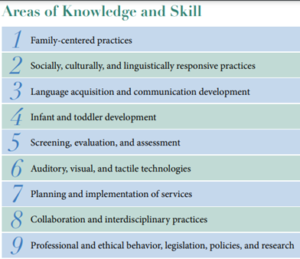Related Products
For Parents
Related Teacher Tools Takeout Items
Improved Family Connections via Tele-Intervention
 Can face-to-face intervention services for young children be replaced with tele-intervention? YES. Can remote services result in language development outcomes as good or BETTER than face to face services. YES! There are resources available to assist any interventionist in providing high quality services via tele-intervention. These techniques can help us all connect with families in a meaningful, and perhaps more effective manner.
Can face-to-face intervention services for young children be replaced with tele-intervention? YES. Can remote services result in language development outcomes as good or BETTER than face to face services. YES! There are resources available to assist any interventionist in providing high quality services via tele-intervention. These techniques can help us all connect with families in a meaningful, and perhaps more effective manner.
The centerpiece of Part C Early Intervention services is that they occur, to the maximum extent possible, in natural environments or settings that are typical for a same-aged infant or toddler without a disability. Having a parent at home full-time with an infant or toddler is no longer a societal norm. Early interventionists often struggle to find a time in the schedule of a busy family with working parents to provide early intervention services. In present times, with parents who are Millennials and widespread communication via media devices, there may be little familiarity in inviting someone into your home to exchange information.
| In a letter [PDF] sent in July 2006 to all state early intervention coordinators,1 officials in the federal government noted that “many young children with hearing loss may not be receiving the early intervention or other services they need in a timely manner that will enable them to enter preschool and school ready to succeed.” |
Research2 has clearly illustrated that young children have significantly better language scores at age 5 years when they have been enrolled early in intervention services AND when the family is highly involved in carrying out the strategies recommended by early interventionists. Many parents would feel the need to ‘make their home presentable’ before having someone outside their family circle come and visit. This on top of the demands of a young family and working parents often can lead to delayed or missed intervention appointments. If families do not feel comfortable having someone in their home then the success of early intervention may suffer, even with the most highly trained and dedicated interventionist.
|
Benefits of Tele-Intervention7
|
Even as early as 20133, research indicated that tele-intervention is a promising cost-effective method for delivering high quality early intervention services to families of children who are deaf or hard of hearing. In fact, even then the children who had families who received tele-intervention scored significantly higher on an expressive language measure as compared to the in-person group. A measure of Parent Engagement was also statistically better for families involved in tele-intervention.
A 2017 multi-state study4 that evaluated the benefits of early intervention via telepractice also found that children in the tele-intervention group scored significantly higher on language measures. Analysis of video recordings of tele-intervention versus in-person home visits resulted in higher scores for provider responsiveness and parent engagement. A 2018 review of 23 peer-reviewed studies5 found that 18 viewed the use of tele-intervention positively while the remaining 5 reported mixed conclusions and the need for more data. Current evidence in the literature indicates that tele-intervention can be an effective model for delivering family-centered early intervention for children who are deaf or hard of hearing.
The knowledge base to provide early intervention services, whether provided remotely or in-person, can be daunting as demonstrated by the following list of Areas of Knowledge and Skill.
Resources for Skills and Strategies
NCHAM, or the National Center for Hearing Assessment & Management1, is a centralized wealth of information for anyone who is starting to provide early intervention services, or to keep informed of the latest trends and research.
The NCHAM eBook, Chapter 186: Early Intervention for Children Birth to 3: Families, Communities & Communication is a primer for the basics, and the nuances, of providing quality early intervention services.
The NCHAM Early Intervention Resource Pages include the following links:
- Early Intervention System Information
- Early Intervention Guidelines and Requirements
- Importance of Early Communication and Communication Options
- Hearing, Amplification, and Cochlear Implants
- Assessment Tools for Communication/Language and Auditory Development
- Early Intervention Curriculum and Training Materials
- Additional Early Intervention Materials, Web Sites, and Presentations
NCHAM also has a Practical Guide to the Use of Tele-Intervention in Providing Early Intervention Services to Infants and Toddlers Who are Deaf or Hard of Hearing7. NCHAM established a tele-intervention learning community comprised of providers and researchers to share experiences, address challenges and systematically address relevant issues. Contact this thriving community by sending a message to Facebook.
References
- 1. http://www.infanthearing.org/earlyintervention/
- 2. http://depistageneonatal.be/pro_surdite/articles/Moeller.pdf
- 3. https://www.ncbi.nlm.nih.gov/pmc/articles/PMC4352990/
- 4. https://journals.lww.com/iycjournal/toc/2017/04000
- 5. https://doi.org/10.1177/1357633X18755883
- 6. http://www.infanthearing.org/ehdi-ebook/2020_ebook/18%20Chapter18EarlyIntervention2020.pdf
- 7. http://www.infanthearing.org/ti-guide/index.html

